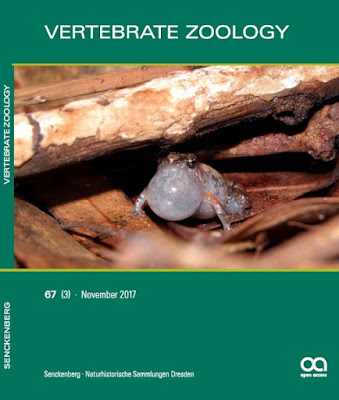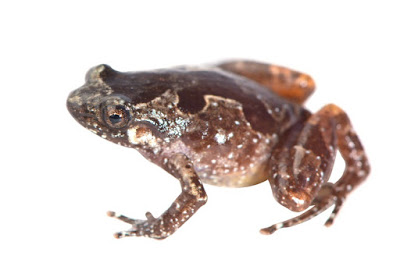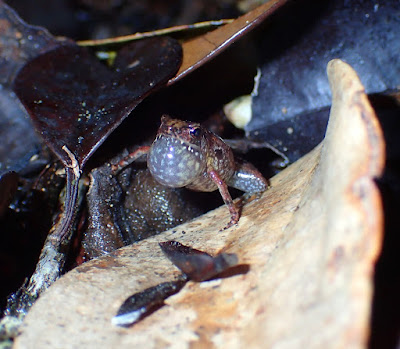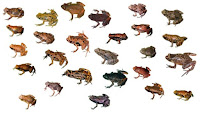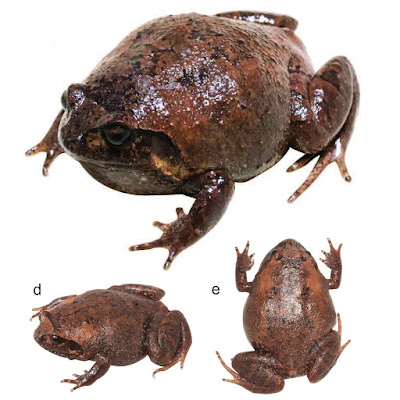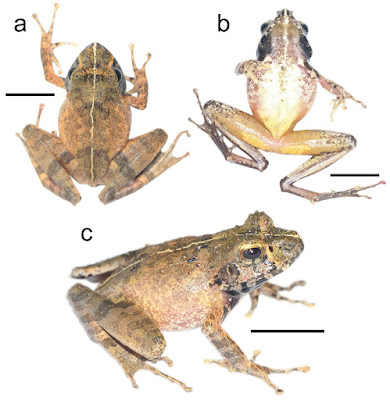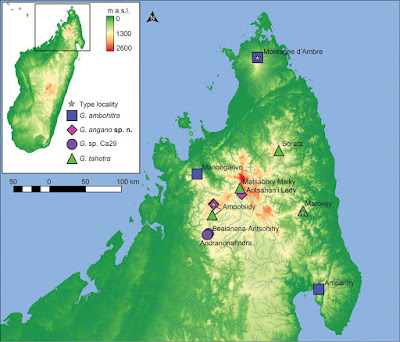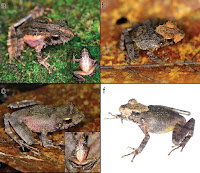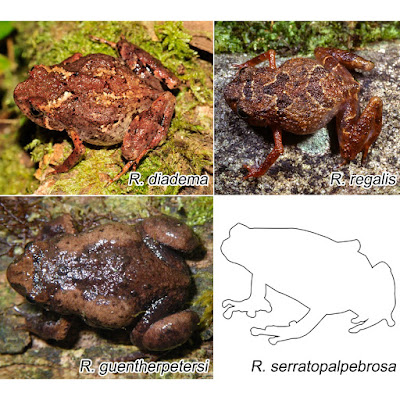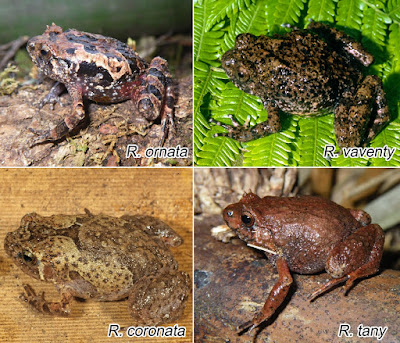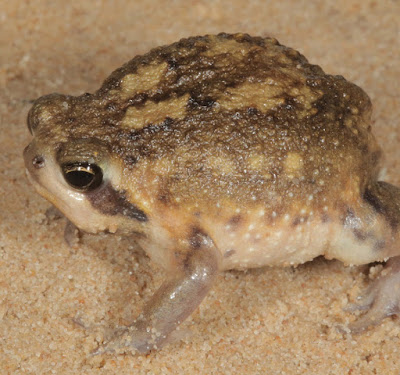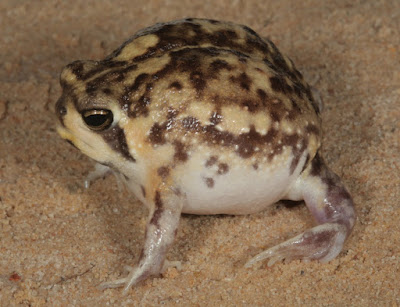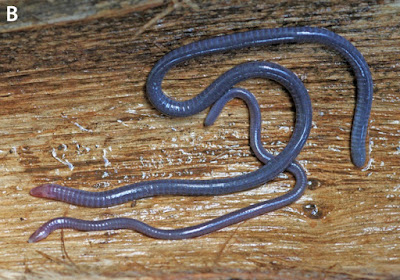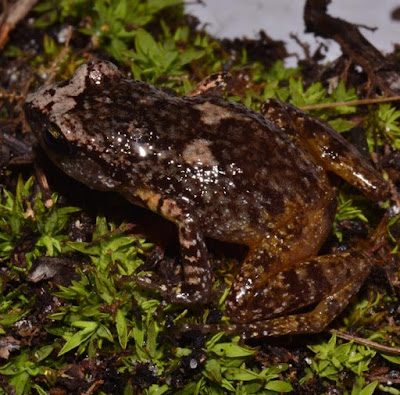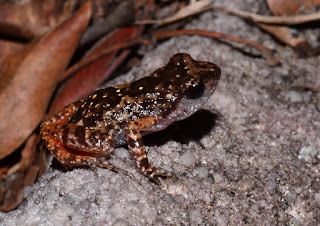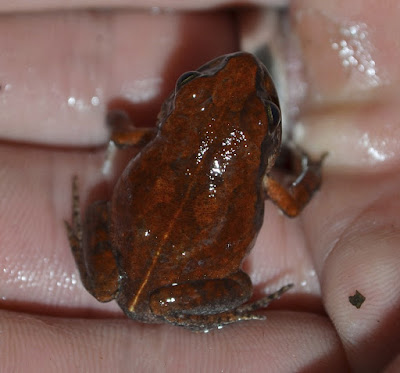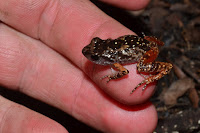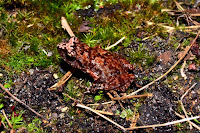 |
| S. angeluci, S. huwei, S. iharana, S. larinki, S. maledicta, S. mamitika, S. sorata, S. yanniki, S. meikeae, S. obscoena, S. davidattenboroughi, S. nigrorubra, S. achillei, S. diutissima, S. pardus, S. edmondsi, S. fusca, S. jeannoeli, S. spandei, S. garraffoi, S. analanjirofo, S. miovaova, S. makira, S. betampona, S. dolchi & S. contumelia Rakotoarison, Scherz, Glaw, Köhler, Andreone, Franzen, Glos, Hawlitschek, Jono, Mori, Ndriantsoa, Raminosoa, Riemann, Rödel, Rosa, Vieites, Crottini & Vences. 2017 Vertebrate Zoology. 67(3); 271–398. |
Abstract
The genus Stumpffia Boettger, 1881 currently contains 15 named, small to miniaturized frog species, classified in the endemic Malagasy subfamily Cophylinae of the family Microhylidae. Stumpffia are terrestrial frogs with a largely unknown biology, probably due to their small size and secretive habits. Previous studies have suggested a large proportion of undescribed diversity in the genus. We revise the genus on the basis of a combination of molecular, bioacoustic, and morphological data and describe 26 new species that are all genetically divergent, almost all of them with high pairwise genetic divergences > 4% p-distance in a segment of the mitochondrial 16S rRNA gene and concordant differentiation in a segment of the nuclear Rag-1 gene. The majority of the new species can also be distinguished by the structure of their advertisement calls (where bioacoustic data are available), and in most comparisons the species can also be distinguished morphologically. Furthermore, a molecular phylogeny reconstructed from DNA sequences of one nuclear and four mitochondrial gene segments revealed that in many cases, morphologically similar species are not each other’s closest relatives, thus confirming their identity as independent evolutionary lineages and revealing repeated phenotypic divergence and convergence among and within clades. The phylogeny distinguishes four main clades in the genus: Clade A containing 17 species (Stumpffia be, S. hara, S. megsoni, S. staffordi, S. psologlossa, S. analamaina, S. gimmeli, S. madagascariensis, S. pygmaea, S. angeluci sp. nov., S. huwei sp. nov., S. iharana sp. nov., S. larinki sp. nov., S. maledicta sp. nov., S. mamitika sp. nov., S. sorata sp. nov., and S. yanniki sp. nov.) mostly from northern and northwestern Madagascar, generally characterized by limited digital reduction and divided in subclades of comparatively large, small, and miniaturized body size, respectively; Clade B with four species (S. miery, S. meikeae sp. nov., S. obscoena sp. nov., and S. davidattenboroughi sp. nov.) morphologically ranging from miniaturized with strong digital reduction to comparatively large-sized; Clade C with 18 species (S. grandis, S. kibomena, S. roseifemoralis, S. tetradactyla, S. nigrorubra sp. nov., S. achillei sp. nov., S. diutissima sp. nov., S. pardus sp. nov., S. edmondsi sp. nov., S. fusca sp. nov., S. jeannoeli sp. nov., S. spandei sp. nov., S. garraffoi sp. nov., S. analanjirofo sp. nov., S. miovaova sp. nov., S. makira sp. nov., S. betampona sp. nov., and S. dolchi sp. nov.) mostly distributed in eastern and northeastern Madagascar, containing species of comparatively large size as well as small-sized species, many of which are characterized by a moderate degree of digital reduction; and Clade D with two miniaturized species (S. tridactyla and S. contumelia sp. nov.) with strong digital reduction, which form the sister group of all other Stumpffia. Two of the newly described species (S. angeluci and S. maledicta) are not separated by the 4% threshold in the 16S gene but occur in sympatry and do not share Rag-1 haplotypes. To achieve a comprehensive review of this species-rich genus, we provide simplified differential diagnoses and descriptions and abbreviated descriptions of morphological variation. Despite the large number of Stumpffia species newly described herein, we identify several additional candidate species with currently insufficient data to warrant formal description, and highlight that some species such as S. analanjirofo, S. gimmeli, S. kibomena, S. madagascariensis, S. roseifemoralis and S. obscoena are composed of two or more deep mitochondrial lineages that might also turn out to be distinct taxa after in-depth study. We confirm Stumpffia as a genus of highly microendemic frogs with many species apparently restricted to very small ranges, and provide evidence that two of the new species (S. achillei and S. davidattenboroughi) do not construct foam nests but lay their eggs in wet places in the leaf litter, or in cavities such as empty snail shells. We propose a conservation status for all the described species according to IUCN Red List Criteria, but also discuss several problems applying these criteria to such microendemic and poorly known frogs.
Key words: Amphibia; Anura; Microhylidae; diversity; systematics; bioacoustics; molecular genetics; morphology; microendemism
Andolalao Rakotoarison, Mark D. Scherz, Frank Glaw, Jörn Köhler, Franco Andreone, Michael Franzen, Julian Glos, Oliver Hawlitschek, Teppei Jono, Akira Mori, Serge H. Ndriantsoa, Noromalala Rasoamampionona Raminosoa, Jana C. Riemann, Mark-Oliver Rödel, Gonçalo M. Rosa, David R. Vieites, Angelica Crottini and Miguel Vences. 2017. Describing the Smaller Majority: Integrative Taxonomy Reveals Twenty-Six New Species of Tiny Microhylid Frogs (Genus Stumpffia) from Madagascar. Vertebrate Zoology. 67(3); 271–398.
A swathe of Stumpffia: 26 new frog species markscherz.com/archives/3441 @MarkScherz
---------------------------------------------------------------
روابط التحميل والمشاهدة، الروابط المباشرة للتحميل
او
شاهد هذا الفيديو القصير لطريقة التحميل البسيطة
كيف تحصل على مدونة جاهزة بآلاف المواضيع والمشاركات من هنا
شاهد قناة منتدى مدونات بلوجر جاهزة بألاف المواضيع والمشاركات على اليوتيوب لمزيد من الشرح من هنا
رابط مدونة منتدى مدونات بلوجر جاهزة بآلاف المواضيع والمشاركات في أي وقت حــــتى لو تم حذفها من هنا
شاهد صفحة منتدى مدونات بلوجر جاهزة بألاف المواضيع والمشاركات على الفيس بوك لمزيد من الشرح من هنا
شاهد صفحة منتدى مدونات بلوجر جاهزة بألاف المواضيع والمشاركات على الفيس بوك لمزيد من الشرح من هنا
تعرف على ترتيب مواضيع منتدى مدونات بلوجر جاهزة بآلاف المواضيع والمشاركات (حتى لا تختلط عليك الامور) من هنا
ملاحظة هامة: كل عمليات تنزيل، رفع، وتعديل المواضيع الجاهزة تتم بطريقة آلية، ونعتذر عن اي موضوع مخالف او مخل بالحياء مرفوع بالمدونات الجاهزة بآلاف المواضيع والمشاركات، ولكم ان تقوموا بحذف هذه المواضيع والمشاركات والطريقة بسيطة وسهلة. ــــــــــــــــــــــــــــــــــــــــــــــــــــــــــــــــــــــــــــــسلامـ.


